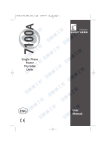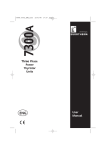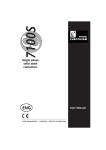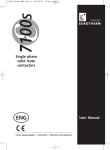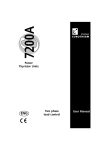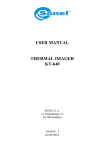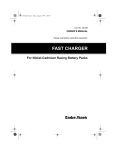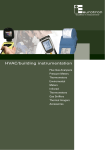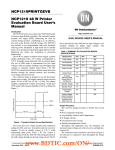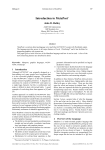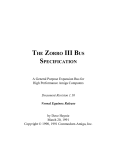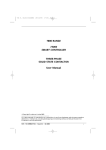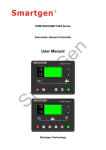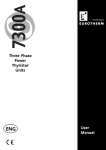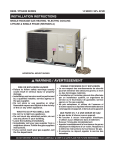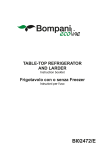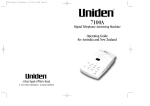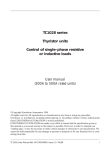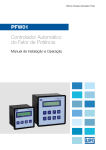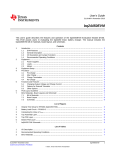Download 7100A ADVANCED CONTROLLERS SINGLE-PHASE
Transcript
7100A ADVANCED CONTROLLERS SINGLE-PHASE POWER THYRISTOR UNITS 7000 RANGES User Manual © Copyright Eurotherm Limited 2002 All rights reserved. All reproduction or transmission in any form whatsoever and using any procedure (electronic or mechanical, including photocopying and recording) without written permission from Eurotherm is strictly prohibited. Ref.: HA176499 ENG - Issue 2.0 - 11/2005 i Contents CONTENTS Page European directives and applicable standards . . . . . . . . . .iii Commissioning flowchart . . . . . . . . . . . . . . . . . . . . . . . . . . . . .iv Chapter 1 Identification of power thyristor units . . . . . .1-1 Chapter 2 Installation . . . . . . . . . . . . . . . . . . . . . . . . . . . . .2-1 Chapter 3 Firing modes . . . . . . . . . . . . . . . . . . . . . . . . . . . .3-1 Chapter 4 Control and limits . . . . . . . . . . . . . . . . . . . . . . .4-1 Chapter 5 Alarms . . . . . . . . . . . . . . . . . . . . . . . . . . . . . . . . .5-1 Chapter 6 Maintenance . . . . . . . . . . . . . . . . . . . . . . . . . . . .6-1 Eurotherm . . . . . . . . . . . . . . . . . . . . . . . . . . . . . . . . . . . . . . .7-1 PURPOSE OF MANUAL This is the Issue 2.0 User Manual. It describes the Basic Version and all options for 7100A series power thyristor units with current ratings from 16 A to 250 A. ii 7100A User Manual European directives and applicable standards EUROPEAN DIRECTIVES AND APPLICABLE STANDARDS COMPLIANCE WITH PRODUCT STANDARD 7100A products comply with the terms of product standard EN 60947-4-3 ‘Contactors and motor-starters - AC semiconductor controllers and contactors for non-motor loads’. CE LABELLING 7100A products installed and used in accordance with the user manual, bear CE labelling on the basis of compliance with the essential requirements of the European Low Voltage Directive 73/23 EEC dated 19 February 1973, modified by 93/68/EEC dated 22 July 1993 and the Electromagnetic Compatibility Directive 89/336/EEC dated 3 May 1989 modified by 92/31/EEC dated 28 April 1992 and 93/68/EEC dated 22/07/93. SAFETY The units have IP20 protection rating as defined by standard IEC 60529. External wiring must comply with standards IEC 60364-4-43 and IEC 60943. Copper cables and conductors must be used, rated to a temperature of 75°C (167°F). ELECTROMAGNETIC COMPATIBILITY (EMC) 7100A products installed and used in accordance with the user manual, are designed for an industrial environment and must not be used in the home. EMC TEST STANDARDS The units comply with the following EMC test standards, in accordance with the ‘AC semiconductor motor controllers and conductors for non-motor loads’ standard EN 60947-4-3: Immunity: EN 61000-4-2, EN 61000-4-3, EN 61000-4-4, EN 61000-4-5, EN 61000-4-6, EN 61000-4-11 Radiated emissions: Conducted emissions: CISPR 11 (mod 1990) CISPR 11 (mod 1990) Class A, Group 2 (near zero voltage switching) EMC FILTER (conducted emissions) For facilities required to comply with the levels stipulated under the generic standard for conducted emissions, EN 50081-2, Eurotherm can provide optional filters on units up to 100 A: - external filters for thyristor firing angle variation units EMC GUIDE To help you deal with installation-dependent electromagnetic interference effects, Eurotherm provides an ‘Electromagnetic compatibility’ installation guide (ref. HA 025464) which sets out best current practice regarding EMC. DECLARATION OF COMPLIANCE An EC declaration of compliance is available on request. 7100A User Manual iii Flowchart COMMISSIONING FLOWCHART Check characteristics Characteristics correspond to product code Chapter 1 Wiring Supply protection, protective earth, power, control Chapter 2 Auxiliary power supply If external supply (for electronics or fan) Page 2-12 I lim potentiometer Chapter 4, Page 5-7 Power control (VI) : Calibrate Imax and Pmax while not firing for given load Ilim,VIlim potentiometers Control signal "HRC" terminal Chapter 4, Apply control signal "ANA" terminal block Pages 2-10, 2-11 Control and limit in I2, V2CL control: Calibrate minimum current ICO option (over-current alarm): Calibrate maximum current Power up Check firing Alarms signalled Chapter 5 GRF, DLF, ICO LEDs ON, Heat LEDs Chapter 3 I lim potentiometer Chapter 4,, Page 5-7 Optimise firing delay for inductive load DLY potentiometer Page 3-3 Adjust DLF alarm (if conditions met) CHK/SET push button Page 5-5, 5-6 Normal operation Adjust ICO calibrations and threshold while firing at full rate iv Chapter 3 7100A User Manual Identification Chapter 1 IDENTIFICATION OF POWER THYRISTOR UNITS Contents Page 1.1. General presentation . . . . . . . . . . . . . . . . . . . . . . . . . . . . . . . . . . . .1-2 1.2. Technical specifications . . . . . . . . . . . . . . . . . . . . . . . . . . . . . . . . . .1-7 1.2.1. Power . . . . . . . . . . . . . . . . . . . . . . . . . . . . . . . . . . . . . . . . . . . . .1-7 1.2.2. Load . . . . . . . . . . . . . . . . . . . . . . . . . . . . . . . . . . . . . . . . . . . . . .1-7 1.2.3. Dimensions . . . . . . . . . . . . . . . . . . . . . . . . . . . . . . . . . . . . . . . .1-7 1.2.4. Control . . . . . . . . . . . . . . . . . . . . . . . . . . . . . . . . . . . . . . . . . . . .1-8 1.2.5. Firing Modes . . . . . . . . . . . . . . . . . . . . . . . . . . . . . . . . . . . . . . .1-8 1.2.6. Control . . . . . . . . . . . . . . . . . . . . . . . . . . . . . . . . . . . . . . . . . . . .1-8 1.2.7. Signalling . . . . . . . . . . . . . . . . . . . . . . . . . . . . . . . . . . . . . . . . . .11.2.8. Alarms . . . . . . . . . . . . . . . . . . . . . . . . . . . . . . . . . . . . . . . . . . . .1-9 1.2.8.1. Load Monitorin Alarms . . . . . . . . . . . . . . . . . . . . . . . . .1-9 1.2.8.2. OverLoad Alarms . . . . . . . . . . . . . . . . . . . . . . . . . . . . . .1-9 1.2.8.3. Alarm Relay . . . . . . . . . . . . . . . . . . . . . . . . . . . . . . . . . . .1-9 1.2.9. Protection . . . . . . . . . . . . . . . . . . . . . . . . . . . . . . . . . . . . . . . . .1-10 1.2.10. Mounting . . . . . . . . . . . . . . . . . . . . . . . . . . . . . . . . . . . . . . . . .1-10 1.2.11. Environment . . . . . . . . . . . . . . . . . . . . . . . . . . . . . . . . . . . . . .1-10 1.3. Coding . . . . . . . . . . . . . . . . . . . . . . . . . . . . . . . . . . . . . . . . . . . . . . . .1-11 7100A User Manual 1-1 Identification Chapter 1 IDENTIFICATION 1.1. GENERAL PRESENTATION 7100A series power thyristor units are used to control the electrical power of single phase industrial loads of all types. The load controlled may may be : high or low temperature coefficient resistive loads, short wave infrared elements or transformer primaries. Current ratings vary from 16 A to 250 A (see coding), at voltages of 100 V to 500 V. 7100A series power thyristor units (rating up to 100 A) comprise two channels, one controlled by thyristors, and one direct internal channel. 7100A units above 125 A only comprise a single controlled channel. Lite version : • Units without options • One Alarm option (GRF or DLF) or one Control option (V2CL or I2) These configurations can be combined depending on the case, with the open loop code (OL) or the transformer primary code (XFMR). • The Power Control option (VICL) is not available on the lite version Full version : • Power Control option (VICL) only or combined with other options • Alarm option (GRF or DLF) combined with Control option (V2CL,I2 or VICL) • Overload option ICO 1-2 7100A User Manual Identification 1.1.1. 7100A unit from 16A to 40A ‘lite’ version Power terminals (supply side) ε User label EUROT HERM 1/L1 3/L2 2/T1 4/T2 Protective earth terminal 7100 A 16 A / 500 V PE Internal wiring diagram Rating (nominal current, nominal voltage) Electronics power supply ON H E AT Auxiliary supply terminal references (if specified) A/F Control terminal references 16 230 17 18 N ANA 31 0 VA 32 RI 33 5 VA Firing request (Burst mode or single cycle) Control terminal block Power terminals (load side) Figure 1-1 Auxiliary supply terminal block (if specified) General view of 7100A power thyristor unit 16A to 40A ‘lite’ version 7100A User Manual 1-3 Identification 1.1.2. 7100A units from 16A to 63A ‘full’ version and 63 A ‘lite’ ε EUROTHERM 7100 A 63A / 500 V 1/L1 3/L2 2/T1 4/T2 PE GRF DLF ON Figure 1-2 1-4 A/F 16 230 17 18 N ANA 31 0 VA 32 R 33 I 5 VA ALR 71 1a 72 1b H E AT General view of 7100A power thyristor unit 16A to 63A ‘full’ version and 63 ‘lite’ 7100A User Manual Identification 1.1.3. 7100A units from 80A to 100A ‘lite’ and ‘full’ version Power terminals (supply side) Rating: nominal current nominal voltage ε EURO THER M User label Protective earth terminal 7100 A 100 A / 500 V 1/L1 3/L2 2/T1 4/T2 PE Internal power wiring diagram V2CL, VICL and I2 options: Current calibration V2CL or VICL options: Current limit + GRF option: serious alarms A I LIM I LIM GRF DLF option: diagnostic alarm CHK SET DLF + ALR 71 1a 72 1b ADJ. CA 66 0 L VC 67 HRC H E AT VICL option: Power calibration A/F 16 230 17 18 N Firing request (Phase Angle) DLF option: Diagnostic alarm push button VI LIM ON ANA 31 0 VA 32 R 33 I 5 VA Electronics power supply Control terminal references Control connectors Power terminals (load side) Figure 1-3 General view of 7100A power thyristor unit 80A to 100A ‘lite’ and ‘full’ version 7100A User Manual 1-5 Identification 1.1.4. 7100A units from 125A to 250A ‘lite’ version only Protective Earth Terminal Power Terminal (Supply side) 1/L1 Not used Internal Fuse Compartment Internal Wiring (Internal fuse for 125 to 250 A units) ε EURO THER M Over Temperature Alarm (250 A only) 710 0A 250 A / 500 V PE 1/L1 2/T1 T° GRF CHK SET DLF ON EN 60947-4-3 1a 1b 73 74 230 N L2 21 22 MSF 16 17 18 EXT 0VA RI 5VA 31 32 33 A/F ANA ALR HEAT 3a 3b 75 76 Control Terminals Fan Power Supply (250 A only) 2/T1 Power Terminal (Load Side) Figure 1-4 1-6 Not used Fan (250 A only) General view of 7100A power thyristor unit 125A to 250A ‘lite’ version only 7100A User Manual Identification 1.2. TECHNICAL SPECIFICATIONS 1.2.1. Power Nominal current Nominal voltage Frequency Dissipated power Cooling 16A to 250A at 45°C (see product code) 100 V to 500 V (see code). Use from 47 to 63 Hz 1.3 W (approx.) per amp. Ratings ≤ 100 A: Natural convection Ratings ≥ 125 A: 115 V or 230 V fan, consumption 10 VA 1.2.2. Load Single-phase industrial load: The categories of use applicable for each unit are indicated on the identification label • AC-51 Non-inductive or low inductance loads, furnace resistances (Resistive load with low temperature coefficient). • AC-55b Switching of incandescent lamps (Short wave infrared elements, SWIR units ≤ 100 A only). • AC-56a Switching of transformers (Transformer primaries and high temperature coefficient resistive loads). Categories of use 1.2.3. Dimensions Rating (A) Height (mm) All Options 16 to 40 156 Lite Length (mm) Full Depth (mm) Lite Base (1) Option (2) 193 218 Full 52,5 70 156 70 70 212 237 80 to 100 226 96 96 215 243 243 125 to 250 423 144 N/A 372 372 N/A 63 237 237 Note (1) : Basic product, without alarm option or control (except V2 and OL) Note (2) : Product with one control option (I2 or V2CL) or one alarm option (GRF or DLF) 7100A User Manual 1-7 Identification 1.2.4. Control Supply Control type Self-powered from line or external power supply (115 V or 230 V +10%; -15%). Consumption: 10 VA. Analogue (digital communication with option) • either remote analogue setpoint 0-5 V or 0-10 V (100 kΩ input), 0-20 mA or 4-20 mA (250 Ω input) • or manual setpoint (potentiometer); 5 V supply available for use with 10 kΩ potentiometer. 1.2.5. Firing modes Zero crossing firing Firing angle variation • Burst mode, base time 16 or 64 cycles • Single-cycle, 1 base cycle • Advanced single-cycle, 1 base cycle (firing by whole cycles, non-firing by half cycles). • Phase angle 1.2.6. Control Control parameter Linearity and Stability Current limit (V2CL option) Calibration Transient current limit (XFMR option) 1.2.7. Signalling 1-8 • Standard: Load voltage squared (V2) • Option: - Apparent power (V . I, VICL option) up to 100 A only - Load current squared (I2 option) in Phase angle - Open loop in Phase angle. Better than ±2% of full scale. Option, depending on firing mode: • Phase angle: Automatic control transfer (V2 <-> I2 or V . I <-> I2 ) Current recalibration set by potentiometer on front panel. • Burst mode, 16 cycle base: Current limit with fixed threshold, set by potentiometer on front panel. A control signal is available in V . I control for power and current calibration and for maintenance. Option to control transformer primaries in Burst mode: • Transformer magnetisation firing angle ramp on first firing and after firing is stopped for 5 seconds or more. • Delay on first firing set by potentiometer on front panel. For all loads in Phase Angle firing: Safety ramp with each change of setpoint. Electronics supply present: green ‘ON’ LED. Thyristor firing request: green ‘HEAT’ LED. 7100A User Manual Identification 1.2.8. ALARMS (Options) 1.2.8.1. Load Monitoring alarms (Options) • Serious alarms (GRF option) Total load failure and thyristor short circuit detection Signalling Red ‘GRF’ LED and alarm relay contact • Diagnostic alarm (DLF option) Partial load failure detection. Signalling Settings Orange ‘GRF’ LED and alarm relay contact. Monitoring diagnosis, alarm adjustment and resetting using push button on front panel. Detects the failure of at least one heating element for six identical elements connected in parallel. The DLF option includes the GRF serious alarm monitoring. Sensitivity Extension • Over-temperature alarm Signalling 1.2.8.2. Overload alarms • Overload alarm (ICO Option) For all fan-cooled units (≥ 125 A), the unit cuts out if the temperature threshold is exceeded. Red ‘T°’ LED if one of the I2, VI or CL alarms or regulation options is selected. Alarm relay contact with any one alarm. (Option) Cut-out if current threshold exceeded Only available for Zero crossing firing with DLF option (not available with Short wave infrared elements, transformers and codes VICL and V2CL) Two alarm thresholds: instantaneous current and rms current. Simultaneous current threshold adjustable from 20 to 100% using potentiometer on front panel. Signalling Red ‘ICO’ LED and alarm relay contact. Acknowledged by logic input. 1.2.8.3. Alarm relay Available with one of the Alarm options. The relay contact (0.25 A/230 Vac; 32 Vdc) is either open on alarm or closed on alarm depending on the product code. Eurotherm’s policy of continuous product improvement and development means that the specifications in this document may be modified without prior notice. 7100A User Manual 1-9 Identification 1.2.9. Protection Electrical protection Thyristors IP20 without adding additional protection. Varistor and RC snubber High speed fuse: • rating ≤ 100 A: external (see code) • rating ≥ 125 A: internal. No fuse for Short wave infrared elements in Burst mode and Single-cycle firing, or Phase angle without Current limit. 1.2.10. Mounting Mounting type Attachment plate fixed to unit: • on symmetrical EN50022 DIN rail or • bulkhead mounting (for ratings ≥ 125 A: bulkhead mounting only) 1.2.11. Environment Use Storage Pollution Humidity Over-voltage 1-10 0 to 45 °C at nominal current, max altitude 2000 m -10°C to 70°C. Degree 2 acceptable (defined by IEC 664). RH 5% to 95%, non-condensing, non-streaming. Over-voltage category II (as defined by IEC 664). 7100A User Manual 1.3. CODING Identification Basic selection Ratings 7100A CODING: 1 / 2 / 3 / 4 / 5 / 6 / 7 / 8 / 9 / 10 / Ratings 1. Nominal current Basic selection Code 6. Firing mode Code 16 amps 25 amps 40 amps 63 amps 80 amps 100 amps 125 amps 160 amps 200 amps 250 amps 16A 25A 40A 63A 80A 100A 125A 160A 200A 250A Phase angle PA 2. Nominal voltage Advanced single-cycle: 1 base cycle non-firing by half cycles Burst mode: Single-cycle: 1 base cycle base time 16 cycles base time 64 cycles ASC FC1 C16 C64 7. XXXX Code 8. Input Code 100V 115V 120V 127V 200V 208V 220V 230V 240V 277V 400V 460V 480V 500V Analogue signal: current from 0 mA to 20 mA current from 4 mA to 20 mA voltage from 0 V to 5 V voltage from 0 V to 10 V 0mA20 4mA20 0V5 0V10 9. Manual language Code 10. Selected options Code 3. Power supply for electronics Code Self-powered (standard) External 115 V supply SELF 115V Base version: No options, Standard V2 control End of code NONE External 230 V supply 230V Version with options: Selection of options YES 4. Fan power supply Code ≤ 200A: No fan ≥ 250A: - 115 V fan and 115 V - 230 V fan and 230 V XXXX 5. Thyristor fuse Code Fuse without fuse blown microswitch Fuse with fuse blown microswitch No fuse FUSE MSFU NONE 100 volts 115 volts 120 volts 127 volts 200 volts 208 volts 220 volts 230 volts 240 volts 277 volts 400 volts 460 volts 480 volts 500 volts 7100A User Manual French English German FRA ENG GER 115V 230V 1-11 Identification Options 11 / 12 / 13 / 14 / 15 Options / 16 / 17 / 18 / 19 Certification Options and Warranty extension 11. Control options Code Voltage control (V2) PA only: Current control (I2) Open loop C16 and PA only: Voltage control (V2) and Current limit Power control (V x I) and Current limit V2 12. Delay on first firing Code Burst firing C16 or C64: Transformer primary Other configurations XFMR XXXX 13. Load Monitoring alarms Code Serious Alarms: Thyristor short-circuit, Total Load failure, over-temperature for rating 250 A Partial load failure and Serious alarms No alarms GRF 14. Load type Code With DLF option: Short wave infrared Low temperature coefficient load SWIR LTCL Without DLF option or High temperature coefficient load XXXX I2 OL V2CL 17. XXXX 18. XXXX 19. Certification option Code No certificate of ‘Compliance with Order’ Certificate of ‘Compliance with Order’ NONE CFMC VICL 20. Warranty extension DLF NONE 15.OverLoad alarm (with DLF option and burst firing only) Overload alarm except codes SWIR, XFMR, VICL and V2CL No over-current alarm ICO XXXX 16. Alarm relay contact Code With alarm option: Contact closed on alarm Contact open on alarm Without alarm option NC NO XX 1-12 Code Without warranty extension Warranty extended to 5 years Code NONE WL005 Installation Chapter 2 INSTALLATION Contents Page 2.1. Safety during installation . . . . . . . . . . . . . . . . . . . . . . . . . . . . . . . . .2-2 2.2. Types of mounting . . . . . . . . . . . . . . . . . . . . . . . . . . . . . . . . . . . . . .2-3 2.2.1. Attachment plate . . . . . . . . . . . . . . . . . . . . . . . . . . . . . . . . . . .2-3 2.2.2. Mounting / Detaching on DIN rails . . . . . . . . . . . . . . . . . . . .2-3 2.2.3. 16 A to 63 A units mounting . . . . . . . . . . . . . . . . . . . . . . . . . .2-4 2.2.3.1. DIN rails mounting . . . . . . . . . . . . . . . . . . . . . . . . . . . .2-4 2.2.3.2. Bulkhead mounting . . . . . . . . . . . . . . . . . . . . . . . . . . . .2-4 2.2.4. 80 A to 100 A units mounting . . . . . . . . . . . . . . . . . . . . . . . . .2-5 2.2.4.1. DIN rails mounting . . . . . . . . . . . . . . . . . . . . . . . . . . . .2-5 2.2.4.2. Bulkhead mounting . . . . . . . . . . . . . . . . . . . . . . . . . . . .2-5 2.2.5. 125 A to 250 A units mounting . . . . . . . . . . . . . . . . . . . . . . . .2-6 2.3. Wiring . . . . . . . . . . . . . . . . . . . . . . . . . . . . . . . . . . . . . . . . . . . . . . . .2-7 2.3.1. Power connections . . . . . . . . . . . . . . . . . . . . . . . . . . . . . . . . .2-7 2.3.1.1. 7100 A units from 16 A to 100 A wiring diagram . . . .2-8 2.3.1.2. 7100 A units from 125 A to 250 A wiring diagram . . .2-9 2.3.2. Control connections . . . . . . . . . . . . . . . . . . . . . . . . . . . . . . . . .2-10 2.3.2.1. Control terminal block . . . . . . . . . . . . . . . . . . . . . . . . .2-10 2.3.2.2. Control signal . . . . . . . . . . . . . . . . . . . . . . . . . . . . . . . . .2-11 2.3.2.3. Power supply for electronics . . . . . . . . . . . . . . . . . . . .2-12 2.3.2.4. Alarm relay contact . . . . . . . . . . . . . . . . . . . . . . . . . . .2-12 2.3.2.5. Acknowledgement signal . . . . . . . . . . . . . . . . . . . . . . .2-12 7100A User Manual 2-1 Installation Chapter 2 installation 2.1. SAFETY DURING INSTALLATION (MOUNTING AND WIRING) Danger! • 7100A power thyristor units must be installed and wired by qualified staff authorised to work on low voltage industrial electrical facilities. • Units must be installed in a fan-cooled cabinet, to ensure that condensation and pollution are excluded, with a class of at least 2 according to IEC 664. We recommend fitting fan-cooled cabinets with a fan failure detection device or a thermal safety cut-out. The cabinet must be closed and connected to the protective earth according to IEC 60364 or applicable national standards. • Units must be mounted with the heatsink positioned vertically, and with no obstructions above or below the unit which could reduce or hamper air flow. If several units are fitted in the same cabinet, arrange them such that air from one unit is not drawn in by the unit above. Leave a gap of at least 10 mm between adjacent units. ` Important! ! • Nominal currents correspond to use at ambient temperatures of no more than 45°C. Overheating may cause incorrect operation and may even lead to components being damaged. Danger! • It is the user’s responsibility to wire and protect the facility according to best practice and applicable standards. A suitable device, ensuring that the unit can be electrically isolated from the supply, must be installed upline to enable work to be performed safely. Conductor cross-sections should comply with IEC 60943. Only use copper cables and wires rated for use at 75°C. • Before connecting or disconnecting the unit check that power and control cables and leads are isolated from voltage sources. The protective earth must be connected before any other connections are made and should be the last cable to be disconnected. The protective earth connection terminal is marked with the symbol Important! ! 2-2 • To ensure that 7100A power thyristor units comply with Electromagnetic Compatibility requirements, ensure that the panel or DIN rail to which they are attached is correctly grounded. The ground connection, designed to ensure ground continuity, is not in any way a substitute for the protective earth connection. 7100A User Manual Installation 2.2. TYPES OF MOUNTING Two types of mounting are possible: • DIN rail mounting or • bulkhead mounting with screws. Current rating 16 A to 63 A DIN rail mounting Attachment plate DIN rail Attachment plate Screws One vertical plate One EN50022 symmetric rail One vertical plate 2 x M4 Two EN50022 symmetric rail Two horizontal plates 4 x M4 Two horizontal plates 4 x M6 80 A and 100 A Two horizontal plates ≥ 125 A Bulkhead mounting Not applicable Table 2-1 Attachment details for both mounting types 2.2.1. ATTACHMENT PLATE The attachment plate, shipped fitted to the rear of the 7100A power thyristor unit, is used: • to clip the unit to a DIN rail, or • to screw the unit to a bulkhead. The attachment plate has: • attachment holes for bulkhead mounting, and • two fixed hooks and two mobile hooks for clipping to a DIN rail. (the mobile hooks are moved using a catch and spring). 2.2.2. MOUNTING / DETACHING UNITS IN DIN RAILS • fix one symmetric DIN rail (rating 16 A to 63 A) or two rails (rating 80 A and 100 A), in accordance with the unit dimensions and safety recommendations. • bring the unit up against the rail, engaging the two fixed hooks • push the unit against the rail • clip the unit onto the rail using the mobile hooks, ensuring that they are properly engaged. To detach the unit: • move the mobile hooks downwards by pulling on the catch • unclip the unit from the rail. 7100A User Manual 2-3 Installation 2.2.3. 16A TO 63A UNITS MOUNTING 2.2.3.1. DIN RAIL MOUNTING Attachment plate Attachment hooks EN50022 DIN rail 82 164 Mobile attachment hooks Catch to move mobile hooks downwards Figure 2-1 Attaching the 7100A power thyristor unit to a DIN rail (16A to 63A, rear view) 2.2.3.2. BULKHEAD MOUNTING 164 Attachment plate 156 ± 0.5 For M4 screw For M4 screw Figure 2-2 Bulkhead mounting using an attachment plate (16A to 63A, rear view) 2-4 7100A User Manual Installation 2.2.4. 80A TO 100A UNITS MOUNTING 2.2.4.1. DIN RAIL MOUNTING Upper attachment plate EN50022 DIN rails 125 220 Attachment hooks Mobile attachment hooks Catch to move mobile hooks downwards Lower attachment plate Figure 2-3 Attaching the 7100A power thyristor unit to DIN rails (80A and 100A, rear view). 2.2.4.2. BULKHEAD MOUNTING For 2 M4 screws 210 ± 0.5 220 Upper attachment plate Lower attachment plate For 2 M4 screws 80 ± 0.5 Figure 2-4 Bulkhead mounting using an attachment plate (80A and 100A, rear view). 7100A User Manual 2-5 Installation 2.2.5. 125A TO 250A UNITS MOUNTING BULKHEAD MOUNTING 144 426.7 498 399.7 For2 M6 screws 124 For2 M6 screws Figure 2-5 125A to 250A 7100 A unit mounting 2-6 7100A User Manual Installation 2.3. WIRING 2.3.1. POWER CONNECTIONS 7100A power thyristor units with current ratings up to 100 A are fitted with: • one channel controlled by thyristors • an internal busbar for directly connecting the load to the power supply (direct channel, not controlled by thyristors). The wiring diagram for this range of standard current ratings is shown in figure 2-6. The protective earth terminal PE (marked with the earth symbol) must be wired to the protective earth (see section ‘Safety during installation’). The 7100A units ≥ 100 A, are equiped of : • One thyristor controlled channel and The protective earth terminal PE (marked with the earth symbol) must be wired to the protective earth (see section ‘Safety during installation’). Rating A 16 40 80 to to to Terminal capacity mm2 AWG 25 63 100 2.5 to 6 6 to 16 16 to 35 13 to 9 9 to 5 5 to 2 Torque Nm 1.2 1.8 3.8 Stripping length mm 13 13 20 Table 2-2a Power connection details for ratings from 16 A to 100 A Rating A 125 160 200 250 Terminal capacity AWG mm2 50 70 95 to 120 to 120 to 120 120 0 00 000 - Torque Nm 16,4 (or 28,8) M10 nut to attach eyelet and terminal Stripping length mm ø 10 (or ø 12) Table 2-2b Power connection details for ratings from 125A to 250A Conductor cross-sections should comply with IEC 60943. 7100A User Manual 2-7 Installation 2.3.1.1. 7100A units from 16A to 100A wiring diagram The power connection to 7100A units is between one phase and neutral or between two phases depending on the nominal voltage for the thyristor unit. Supply protection and cut-out, installed by user Ph N / Ph2 Direct channel terminal (supply side) Thyristor protection fuse Internal power wiring diagram Control terminal references Signal input terminal block Controlled channel terminal (load side) ε EUROTHERM 7100A 100 A / 230 V 1/L1 3/L2 2/T1 4/T2 PE Protective earth terminal ON HEAT AN A 31 0 VA 32 RI 33 5 VA Controlled channel terminal (supply side) Protective earth connection Load Direct channel terminal (load side) Figure 2-6 7100A power thyristor unit power and input signal connections (rating ≤ 100 A, no options, self-powered electronics) 2-8 7100A User Manual Installation 2.3.1.2. 7100A units from 125A to 250A wiring diagram The power connection to 7100A units is between one phase and neutral or between two phases depending on the nominal voltage for the thyristor unit. Protective Earth terminal L1 L2 / N Supply protection and cut-out. Istalled by user Controlled channle terminal (supply side) 1/L1 Internal fuse comprtment (thyristor protection) ε EUROTHERM 7100A 160 A / 500 V PE EXT 1/L1 2/T1 L2 21 22 EXT block terminal Connection L2 on N in the case of GRF or DLF option ON 0VA RI 5VA 31 33 230 N 16 17 18 L2 21 22 MSF 32 EXT EN 60947-4-3 FAN ANA HEAT 3a 3b 75 76 MSF Controlled Channel termianl (Load side) 3a 3b 75 76 Contact fusion internal fuse (MSFU) 2/T1 Load Figure 2-7 7100A power thyristor unit power and input signal connections (rating ≥ 100 A, self-powered electronics) 7100A User Manual 2-9 Installation 2.3.2. CONTROL CONNECTIONS Terminal blocks on the underside of the 7100A power thyristor unit are used to connect: • the control signals (analogue and logic) • the auxiliary or electronics supply • alarm relay and acknowledgement contacts Examples of connecting the input signals, external electronics supply and alarm and acknowledgement contacts are shown below. The wires used should be stripped for a length of 6 to 7 mm. 2.3.2.1. Control terminal blocks The control terminal blocks are plug-in screw connectors. The terminal blocks available depend on the power thyristor unit version and the selected options in the product code. The terminals and numbers are marked on the front panel for available terminal blocks. The table below gives details of all terminals and terminal blocks. Terminal block name Terminal description No. Name Purpose ANA 31 32 33 16 17 18 61 62 63 71 72 73 74 66 67 75 76 21 22 A/F (except SELF) DIG.IN ALR ALR ADJ.CAL MSF EXT 0VA RI 5VA 230 115 N 0VD ACK 5VD 1a 1b 1a 1b 0VC HRC 3a 3b L2 N/A 0 V for analogue signals ‘+’ for analogue signals Internal analogue 5 V supply 230 V aux. supply 115 V aux. supply Neutral or second phase 0 V logic signal Acknowledgement 5 V internal logic Alarm relay contact NC contact Alarm relay contact NO contact 0 V calibration Calibration control Relay contact Neutral or 2nd phase in the case of GRF ou DLF option Version Base or Options Terminal Torque capacity Nm mm2 AWG 1,5 16 0,5 2,5 14 0,7 1,5 16 0,5 Alarm Options Alarm Options V x I Control 2,5 14 0,7 2,5 14 0,7 1,5 16 0,5 Microcontact ≥ 125 A Alarm Options ≥ 125 A 2,5 14 0,7 2,4 14 0,7 ICO option Table 2-3 Description of control terminal blocks 2-10 7100A User Manual Installation 2.3.2.2. Control signal The analogue control signal terminal block is labelled ANA. The input available corresponds to the input type selected in the product code (voltage or current and level of values). The signal must be connected between terminals 32 and 31. A typical external signal connection is shown on figure 2-8a. Figure 2-8b shows how to use the internal 5 V voltage (terminal 33 labelled 5VA) for manual control with an external 10 kΩ potentiometer. Important! ! The control signal input is polarised. The ‘+’ of the control signal must be connected to terminal 32 (labelled RI). ON For input code 0V5 only Control signal connector ON HEAT AN A 31 0 VA 32 RI 33 5 VA AN A 31 0 VA 32 RI 33 5 VA HEAT 0V 0V 10 kΩ potentiometer 0% 100% internal +5 V (analogue signals) + Analogue control signal a) b) Figure 2-8 Control signal connection (self-powered unit without alarms) a) external signal, e.g. from Eurotherm series 2000 controller b) manual command from external potentiometer . 7100A User Manual 2-11 Installation 2.3.2.3. Power supply for electronics and fan (option) The power supply for the electronics (auxiliary supply) may be either • internal (self-powered, code SELF) or • external, 115 V or 230 V depending on the product code Only one terminal (16 for 230 V or 17 for 115 V) is available depending on the product code. Terminal 18 (marked N) must be connected to the neutral of the external supply or to the second phase (if the supply is taken between 2 phases). The external supply must be in phase with (or the opposite phase) the line connection. N 230 16 A/F 1A fuses Control terminal references 17 18 Non-standard supply or > 500 V AN A 31 0 VA 32 RI 33 5 VA Note : This terminal block is also used for the fan power supply for 250 A units Auxiliary supply connector (except self-powered) 230 V Figure 2-9 Typical 230 V auxiliary power supply connection 2.3.2.4. Alarm relay contact (alarm option) If one of the alarm options is fitted (Type 1 or Type 2), a relay contact is available on the ‘ALARM’ terminal block, between terminals 71 and 72 or 73 and 74 (see figure 2-10). The type of contact (closed or open on alarm) is determined by the product code. Contact switching capacity: 0.25 A (maximum 250 Vac or 30 Vdc). External user supply for alarm acknowledgement D IG . IN 61 0VD 62 ACK 63 5VD 1b ALR 71 1a 72 D IG . IN 61 0VD 62 ACK 63 5VD HEAT AN A 31 0 VA 32 RI 33 5 VA Alarm acknowledgement connector 0V Acknowledgement by contact or push button Alarm relay contact +5V Figure 2-10 Typical alarm relay contact and external acknowledgement connections 2.3.2.5. Acknowledgement signal (ICO option) With the ICO option, OverLoad and Partial or Total load failure alarms may be acknowledged with a +5 V signal by connecting a contact between terminal 63 (5VD internal) and an ACK logic input (terminal 62) available on the ‘DIG.IN’ terminal block. An external 5 V supply may be used for this acknowledgement (see figure 2-10). Note: The DLF alarm can also be reset with the ‘CHK/SET’ push button. 2-12 7100A User Manual Firing modes Chapter 3 FIRING MODES Contents 3.1. General and firing mode signalling Page . . . . . . . . . . . . . . . . . . . . . . .3-2 3.2. Burst mode (codes C16 and C64) . . . . . . . . . . . . . . . . . . . . . . . . . . .3-2 Firing delay (XFMR option) . . . . . . . . . . . . . . . . . . . . . . . . . . .3-3 3.3. Single-cycle (code FC1) . . . . . . . . . . . . . . . . . . . . . . . . . . . . . . . . . . .3-4 3.4. Advanced single-cycle (code ASC) . . . . . . . . . . . . . . . . . . . . . . . . .3-4 3.5. Phase angle (code PA) . . . . . . . . . . . . . . . . . . . . . . . . . . . . . . . . . . .3-5 3.6. Safety ramp . . . . . . . . . . . . . . . . . . . . . . . . . . . . . . . . . . . . . . . . . . . .3-6 3.6.1. Ramp on start-up . . . . . . . . . . . . . . . . . . . . . . . . . . . . . . . . . .3-6 3.6.2. Magnetisation ramp (XFMR option) . . . . . . . . . . . . . . . . . .3-6 7100A User Manual 3-1 Firing modes 3. Chapter 3 FIRING MODES 3.1. GENERAL AND FIRING MODE SIGNALLING 7300A power thyristor units can be controlled with one of the following thyristor firing types: • thyristor firing angle variation (‘Phase angle’, code PA) • a series of supply voltage cycles with zero crossing firing (‘Burst mode’, codes C16, C64, FC1, ASC) Two indicators (green ‘ON’ and ‘HEAT’ LEDs) are included on the front panel in all versions, either basic or with options. The indicators correspond to the thyristor firing mode as shown in the table below. LED labelling ON HEAT HEAT Signalling Power supply for electronics. Power supply fault (flashing). No reference Neutral (flashing). Thyristor firing request in ‘Burst mode’, ‘Single-cycle’ and ‘Advanced single cycle’ modes. Reminder: ‘Advanced single-cycle’ is only available with 4S and 6D three phase load configuration. Thyristor firing request in ‘Phase angle’ mode. Table 3-1 Firing modes and base LEDs on front panel During normal operation with zero-crossing switching, the ‘HEAT’ LED flashes to match the thyristor firing periods. In normal operation in ‘Phase angle’ mode, the ‘HEAT’ LED varies in brightness depending on the firing angle, with maximum brightness during full firing. 3.2. BURST MODE (codes C16 and C64) ‘Burst mode’ firing is a proportional cycle which delivers a series of whole supply cycles to the load. Thyristor firing and cut-off is synchronised with the supply and occurs at zero crossing. Load Voltage t TNF TF Thyristor firing in ‘Burst mode’ can be described by the firing time (TF) , non-firing time (TNF) and modulation time (TM) where TM = TF + TNF and the Base Cycle Time is equal to the number of cycles firing at 50% of the duty ratio (or 50% of the power supplied to the load): TB = TF = TNF. TM Figure 3-1 Thyristor firing for one of the phases, in ‘Burst mode’ 3-2 The Base Cycle time is equal to 16 cycles for code C16 and 64 cycles for code C64. 7100A User Manual Firing modes FIRING DELAY (XFMR option) In ‘Burst mode’ firing with pure resistive loads, the thyristors are fired at zero voltage crossing to avoid sharp current rises. For an inductive load (e.g. transformer primary), switching the thyristors at zero crossing generates transient over-currents (see figure 3-2a). This transient could cause the high speed thyristor protection fuse to blow in certain cases. Transient Over-Current a) Without Transient b) Vload iload iload Vload 0 0 Delay Angle (0° à 90°) Figure 3-2 Typical switching with inductive load, at zero crossing (a) and with delay (b) Delay Angle Setting 0° 70° D LY 90° To avoid the over-current, the first thyristor firing must be delayed relative to the corresponding zero for each phase. The delay before thyristor firing starts may be adjusted with the ‘DLY’ potentiometer available with the XFMR option (C16 or C64 ‘Burst mode’). Figure 3-3 First firing delay adjustment potentiometer (XMFR option) The ‘DLY’ potentiometer is a 3/4 turn type, and is used to set the delay angle for the first firing: • from 0° (turned anticlockwise to end stop) • to 90° (turned clockwise to end stop). The factory setting for the first firing delay with the XMFR option is 70° (typical value suitable for starting most applications). The optimum firing angle can be adjusted with the ‘DLY’ potentiometer to match the cos of the load to obtain a minimal transient over-current (using an oscilloscope). 7100A User Manual ϕ 3-3 Firing modes 3.3. SINGLE-CYCLE (code FC1) ‘Burst mode’ firing with a single firing or non-firing cycle is known as ‘Single-cycle’. For example, with a setpoint of 50% (corresponding to a duty ratio η = 50%) the modulation comprises 1 firing cycle and 1 non-firing cycle. For duty ratios η < 50% the firing time remains unchanged (1 cycle) and the non-firing time increases. For duty ratios η > 50% the non-firing time remains unchanged (1 cycle) and the firing time increases. 3.4. ADVANCED SINGLE-CYCLE (code ASC) In order to reduce power fluctuations during firing time, ‘Advanced single-cycle’ thyristor firing mode uses: • a whole number of cycles for firing, and • a whole number of half-cycles for non-firing, and. Important: ‘Advanced single-cycle’ firing mode is only available for 4S or 6D three-phase load configuration. For duty ratios η< 50%: For duty ratios η > 50%: - the thyristor firing time is set to one cycle - non-firing occurs for half-cycles. - the non-firing time is set to half a cycle, - firing occurs for whole cycles. By using half-cycles for non-firing time, the modulation time is reduced compared with standard ‘Single-cycle’ mode, which is equivalent to burst mode with one cycle. ‘Advanced Single Cycle’ mode (Code ASC) reduces flicker on short wave infrared elements and is thus less annoying on the eyes. • Standard single-cycle (TF or TNF = 1 cycle) 66.6% power (F= 2 TNF) t TF TNF TM • Advanced single-cycle (TNF = 0.5 cycles: TM reduced) 66.6% power (TF = 2 TNF) t TNF TF TM Figure 3-4 Exemple of Single-cycle and Advanced sigle-cycle firing mode 3-4 7100A User Manual Firing modes 3.5. PHASE ANGLE (Code PA) In ‘Phase angle’ mode the power delivered to the load is controlled by firing the transistors over a part of each supply half-cycle. Control involves varying the thyristor firing angle (θ). It varies with the setpoint signal. The load voltage (vl) and current (il) depend on the three-phase load configuration. a) Resistive Load 4S or 6D Supply Voltage b) Inductive Load 4S or 6D Vload Vload iload iload 0 0 α Θ π α Θ π Figure 3-5 Voltage and current in ‘Phase angle’ mode a) - resistive load; b) - inductive load. 7100A User Manual 3-5 Firing modes 3.6. SAFETY RAMP The safety ramp involves progressively increasing the thyristor firing angle in order to apply the voltage (and current) to the load smoothly and thus reduce the start-up current of loads which have a low resistance when cold and inductive loads. ‘Phase angle’ mode allows the firing angle to be progressively varied on start-up, acting as a safety ramp. 3.6.1. Start-up ramp The start-up ramp is active in the following firing modes: • ‘Phase angle’ (codes V2CL and VICL + PA) • ‘16-cycle Burst mode’ with current limit (codes C16 + V2CL or VICL). The start-up ramp (approx. 16 cycles) is applied on the first firing after the thyristor unit is powered up and after the firing is cut for more than 5 seconds. The initial firing angle is approx. 6°. After the ramp, the firing angle corresponds to the setpoint in ‘Phase angle’ mode; in ‘Burst mode’ the thyristors fire fully once the ramp is complete. Supply voltage Current voltage t Initial firing angle Figure 3-6 Start-up ramp (resistive loads) 3.6.2. Magnetisation ramp (XFMR option) For inductive loads, the safety ramp prepares initial magnetisation. To avoid saturating transformers on power up, the safety ramp acts as a magnetisation ramp. With the XFMR option, after this ramp, the first ‘burst mode’ firing cycle starts with the first firing delay. Supply Voltage Load Voltage Load Voltage t Magnetisation gradiant Delay for first firing Figure 3-7 Transformer primary power-up in ‘Burst mode’ (XFMR option) 3-6 7100A User Manual Control / Limits Chapter 4 4. CONTROL AND LIMITS Contents Page 4.1. Control . . . . . . . . . . . . . . . . . . . . . . . . . . . . . . . . . . . . . . . . . . . . . . . .4-2 4.1.1. Control parameters . . . . . . . . . . . . . . . . . . . . . . . . . . . . . . . . . .4-2 4.1.2. Input / Output ratio . . . . . . . . . . . . . . . . . . . . . . . . . . . . . . . . . .4-2 4.2. Limitation adjustment(options) . . . . . . . . . . . . . . . . . . . . . . . . . . .4-3 4.2.1. Current recalibration (options without power control) . . . .4-4 Settings . . . . . . . . . . . . . . . . . . . . . . . . . . . . . . . . . . . . . . . . . . . . .4-4 Settings with ICO option . . . . . . . . . . . . . . . . . . . . . . . . . . . . . . .4-4 4.2.3. Current and power limitation . . . . . . . . . . . . . . . . . . . . . . .4-5 4.3. Current and power specifications (options) . . . . . . . . . . . . . . . . .4-5 7100A User Manual 4-1 Control / Limits 4. Chapter 4 CONTROL AND LIMITS 4.1. CONTROL 4.1.1. Control parameters 7100A power thyristor units use one of the following control parameters: • rms load voltage squared V2 • rms load current squared I2 • power delivered to load P • Open Loop OL The parameters are defined and explained in the table below: Control Code V2 V2CL VICL I2 Definition Compensation of supply voltage variations Compensation of supply voltage variations with current limit Power control with current and power limits Current squarred control Only available with Phase Angle Mode (code PA) Open loop, no control. The output is the image of the setpoint Only available with Phase Angle Mode (code PA) OL Tableau 4-1 Control parameter use For the Base version (with no options) the standard control parameter is V2. The control parameter must be selected when ordering and forms part of the product code. 4.1.2. INPUT / OUTPUT RATIO The value of the control parameter is proportional to the analogue setpoint signal between 4% and 96% of the scale (see figure 4-1). Control parameter 100% 100 % 96% Vrms ou Irms 75 50 U2 , I2 ou P 25 0% 4% Figure 4-1 Ratio between control system input and output The ratio between the setpoint and the control parameter (V2 , I2 or P) is linear. Four types of input signal are available in the thyristor unit product codes: 0 - 20 mA or 4 - 20 mA, 0 - 5 V or 0 - 10 V. 4-2 7100A User Manual Control / Limits 4.2. LIMITATIONS ADJUSTEMENT (options) The thyristor units are factory-calibrated to their nominal value: IN and PN = VN . IN The limits can be adjusted by adjusting the values with the ‘I lim’ (multi-turn) and ‘VI lim’ (3/4 turn) potentiometers on the front panel. 4.2.1. CURRENT LIMITATION (options without V.I control) The ‘I lim’ potentiometer enables to limit the load current to a chosen value. The active state of the current limitation is indicated by a green flashing LED ‘Ilim’ The new current value Imax can be recalibrated between 20% and 100% of IN. Green LED Flashing: current limit active A ... I LIM + I LIM Current calibration potentiometer Current setting 1. Turn the ‘I lim’ potentiometer fully round in the opposite direction to the arrow (Imax = 20% of IN). 2. Set the thyristor unit firing with 100% setpoint. 3. Measure the current value and use the ‘I lim’ potentiometer to set the desired value of Imax (new thyristor unit rating). Current setting with ICO option In ‘Burst mode’ with the ICO option the ‘I lim’ potentiometer is used to set the over-load alarm (see page 5-8). Over-load detection is signalled by flashing the red ‘...ICO’ LED. To adjust the setting: 1. Turn the ‘I lim’ potentiometer fully round in the direction of the arrow (Imax = 100% of IN). 2. Set the thyristor unit firing with 100% setpoint. 3. Rotate the ‘I lim’ potentiometer (one turn at a time at 5 second intervals) in the opposite direction to the arrow until the ‘...ICO’ indicator starts flashing. 4. Rotate the potentiometer in the direction of the arrow by approx. 2 turns and acknowledge the alarm (settings-calibration for the nominal load current used). Important: If spurious alarms occur rotate the ‘I lim’ potentiometer in the direction of the arrow, one turn at a time, until the alarms cease. 7100A User Manual 4-3 Control / Limits 4.2.2. CURRENT AND POWER LIMITATION With the contol option VICL, the following are available: • ‘I lim’ current calibration potentiometer • ‘VI lim’ power calibration potentiometer • HRC calibration control signal on the ‘ADJ.CAL’ terminal block Recalibration is possible: • current Imax from 20% to 100% of IN • power Pmax from 50% to 100% of (VN . Imax). The HRC setting control signal (‘ADJ.CAL’ terminal block) can be used to aid setting with the ‘I lim’ and ‘VI lim’ potentiometers whether or not the thyristor unit is firing. Setting current and power limitation The value of the DC voltage between terminals HRC (67) and 0VC (66) represents: • The image of the maximum current (‘VI lim’ potentiometer fully turned in the direction of the arrow) • The image of the maximum recalibrated power (1 V corresponds to 100% PN). ADJ .CAL 66 0VC 67 HRC ANA .IN 31 0VA 32 RI 33 5VA The control signal is equal to 1 V if calibrations are nominal (Imax= IN and Pmax = PN). The minimum value of the signal is 0.1 V (Imax = 20% and ‘VI lim’ set to 50% of VN . Imax). Setting: 1. Turn the ‘VI lim’ potentiometer fully round in the direction of the arrow (nominal power). 2. Use the ‘I lim’ potentiometer to set the Imax value. 3. Use the ‘VI lim’ potentiometer to set the Pmax value. Check the resulting power setting on the HRC signal (accounting for Imax) . V Important: The current limitation must be done before adjusting the power limitation. 4-4 7100A User Manual Control / Limits 4.3. CURRENT AND POWER LIMIT SPECIFICATIONS The table below summarises the operation of the limits used in the 7100A series power thyristor units. Firing mode C16 PA Control type Name Potentiometer Action Operation of limit V2CL I lim Thyristor unit current recalibration: set threshold Imax Current limit by threshold. If the maximum of the three currents IM > Imax: firing angle variation. V2 control in ‘Burst mode 16’ VICL I lim Thyristor unit current recalibration: set threshold Imax Current limit by threshold. If the maximum of the three currents IM > Imax: firing angle variation. P control in ‘Burst mode 16’ V2CL VICL I2 VI lim Recalibration of power control loop: set ratio between P and setpoint Power limit by control in ‘Burst mode 16’ taking Pmax into account I lim Thyristor unit current recalibration: set ratio between I (%) and setpoint Current limit by transfer. If the maximum of the 3 currents squared IM2 > V2 (%): Thyristor unit current recalibration: set ratio between I (%) and setpoint Current limit by transfer. If the maximum of the 3 currents squared IM2 > V2 (%): I lim automatic transfer to I2 control by firing angle variation. automatic transfer to I2 control by firing angle variation. VI lim Recalibration of power control loop: set ratio between P and setpoint Power limit by control (variation of firing angle; new ratio between P and setpoint. I lim Current limit by transfer. If (IM2)-(IMin2) > 25% IN2: Thyristor unit current recalibration: set ratio between I (%) and setpoint automatic transfer to IM2. Table 4-2 Operation of current and power limits Reminder: Recalibration sets the unit’s new nominal current rating (IN). 7100A User Manual 4-5 Control / Limits 4-6 7100A User Manual Alarms Chapter 5 ALARMS Contents Page Alarm diagnostic summary . . . . . . . . . . . . . . . . . . . . . . . . . . . . . . . .5-2 5.1.Safety mechanisms . . . . . . . . . . . . . . . . . . . . . . . . . . . . . . . . . . .5-3 5.2. Alarm strategy . . . . . . . . . . . . . . . . . . . . . . . . . . . . . . . . . . . . . .5-3 5.2.1. Firing cut-off . . . . . . . . . . . . . . . . . . . . . . . . . . . . . . . .5-3 5.2.2. Alarm priority . . . . . . . . . . . . . . . . . . . . . . . . . . . . . .5-3 5.2.3. Memorisation . . . . . . . . . . . . . . . . . . . . . . . . . . . . . . .5-3 5.3. Load Monitoring . . . . . . . . . . . . . . . . . . . . . . . . . . . . . . . . . . . .5-4 5.3.1. Setting the DLF alarm . . . . . . . . . . . . . . . . . . . . . . .5-5 5.3.2. PLF or TLF detection . . . . . . . . . . . . . . . . . . . . . . . .5-5 5.3.3. PLF detection sensitivity . . . . . . . . . . . . . . . . . . . . .5-5 5.4. Load type matching . . . . . . . . . . . . . . . . . . . . . . . . . . . . . . . . . .5-5 5.5. Disabling alarms for load failure signalling . . . . . . . . . . . . .5-5 5.6. Functions of DLF alarm push button . . . . . . . . . . . . . . . . . . .5-6 5.6.1. Setting Request . . . . . . . . . . . . . . . . . . . . . . . . . . . . . . . .5-6 5.6.2. Diagnostic . . . . . . . . . . . . . . . . . . . . . . . . . . . . . . . . . . . .5-6 5.6.3. Disabling . . . . . . . . . . . . . . . . . . . . . . . . . . . . . . . . . . . . .5-6 5.7. Over Load Alarm . . . . . . . . . . . . . . . . . . . . . . . . . . . . . . . . . . . .5-7 5.7.1. Availability . . . . . . . . . . . . . . . . . . . . . . . . . . . . . . . . . . .5-7 5.7.2. Alarm conditions . . . . . . . . . . . . . . . . . . . . . . . . . . . . . .5-7 5.7.3. Alarm Actions, Memorisation, Acknowledgement . .5-7 7100A User Manual 5-1 Alarms ALARM DIAGNOSTIC SUMMARY The table below summarises all status LED information needed to diagnose the fault. OPTIONS : All versions ICO Alarm options GRF DLF T° ... ICO A 250 A Red GRF Red DLF Orange ON Green HEAT Green Or HEAT Green DIAGNOSTIC: No firing OverThyristor OverThyristor alarm: current. temperature. short-circuit short-circuit Phase angle Firing or Firing or inhibited Total inhibited zero (see page 5-7) load failure crossing Total load failure Partial load failure Figure 5-1 Diagnosing operation and alarms according to front panel LED status 5-2 7100A User Manual Alarms Chapter 5 ALARMS (Options) 5.1. SAFETY MECHANISMS The alarms on the 7100A protect the thyristors and the load against certain types of abnormal operation and provide the user with information about the type of fault. • Alarms are not under any circumstances a replacement for personnel protection. • The user is responsible for installing independent safety mechanisms which must be inspected regularly. Given the value of the equipment controlled by the 7100A, Danger this is strongly recommended. Eurotherm can supply various types of suitable alarm detector. 5.2. ALARM STRATEGY • Load monitoring (option) : monitoring of load and thyristors • Over Load Alarm (option) : protection against exceeding a current threshold In addition , the unit has active securities : • Network voltage default detection (no network or supply voltage not high enough and frequency error) • Over temperature protection (fan cooled units, 250 A only) 5.2.1. Firing cut-off • ‘Over-Load’ • ‘Overheating’ (for current ratings 250 A only) • ‘Supply voltage’ stops the thyristor firing 5.2.2. Alarm priority Only one alarm is signalled if several faults occur simultaneously. Over load and standard alarms, thermal faults and thyristor short-circuits take priority over load fault display. 5.2.3. Memorisation Load monitoring and standard alarms are not memorised. After an alarm has been detected, and once the fault conditions have cleared, signalling for these alarms (LED and relay) returns to the non-alarm position. OverLaod alarm is memorised and must be acknowledged Thyristor short-circuit and neutral cut-off require repairs. 7100A User Manual 5-3 Alarms 5.3. LOAD MONITORING Two diagnostic options are available : • GRF option (Gross Fault) which permits to detect the following serious faults : Total Load Failure : TLF Thyristor Short-Circuit : THSC Over Heating : T° (for units 250 A only) • DLF option (Diagnostic Load Failure), presents the same fault detection as GRF option with in addition, the Partial Load Failure detection (PLF). Red LED: "Serious faults" Red LED: "Over-temperature" (≥125 A) T° GR F Orange LED: "Partial load failure" CHK SET DLF DLF alarm adjustment and diagnostic push button Figure 5-2 Layout of front panel LEDs with ‘GRF’ and/or ‘DLF’’ option Fault ‘T°’ red Partial Load Failure OFF (PLF) Total Load Failure OFF (TLF) Thyristor Short-Circuit OFF (THSC) Over-temperature (T°) ON ‘GRF’ red LED State ‘DLF’ orange OFF Flashing ON Flashing ON OFF OFF OFF ‘HEAT’ green ON or Flashing OFF Firing stopped Temps de réaction typique No 5 s to 13 s Yes Table 5-1 LEDs for serious alarms or faults with ‘GRF’and/or ‘DLF’ options Note: • 5-4 Thermal faults are signalled by the ‘T°’ LED if one of the alarm options or one of the control options (except V2 and OL) is fitted. The unit is protected against thermal faults whether or not they are signalled.Thermal faults are signalled by the alarm relay if one of the alarm options is fitted. 7100A User Manual Alarms 5.3.1. Setting the DLF alarm This can be set using the push button on the front panel. The PLF detection setting can only be adjusted (reference impedance recalculated) in the following conditions : • rms voltage across load is greater than 40 % of the nominal voltage • rms current is greater than 30% of the rated current • no over-temperature or thyristor short-circuit faults. • in order to guarantee the full scale sensitivity, settings must be done at the load’s nominal temperature Note : PLF settings stay memorised even if a supply cut-out occured 5.3.2. Partial or Total Load Failure Detection PLF detection is only possible under the following conditions : • no over-temperature or thyristor short-circuit faults. • rms voltage across the load greater than 40% of the nominal voltage and, • rms load current greater than 5% of the rated current. Total Load Failure TLF monitoring is only possible under the following conditions : • no over-temperature or thyristor short-circuit faults. • the rms voltage across load is greater than 40 % of the nominal voltage 5.3.3. Partial Load Failure Detection Sensitivity Partial Load Failure Detection Sensitivity can be expressed in terms of a maximum number of load elements connected in parallel for which the unit can detect the failure of one element. The DLF sensitivity guaranted for 1 element out of 6. 5.4. Load type matching PLF detection is adapted to the load type. The type of load controlled is selected when ordering, with the product code: • LTCL (Low Temperature Coefficient Load), or • SWIR (Short Wave InfraRed elements. 5.5. Disabling alarms for load failure signalling PLF fault signalling (‘DLF’ indicator and relay) can be temporarily excluded from alarms by pressing the ‘CHK / SET’ (Check / Setting) push button. If the fault persists, DLF signalling returns to the alarm position. If the ICO option is used, PLF and TLF faults can be excluded from alarms using the external acknowledgement logic input (see ‘Type 2 alarm’). 7100A User Manual 5-5 Alarms 5.6. Functions of DLF alarm push button The push button on the front panel of the unit with the ‘DLF’ option is labelled ‘CHK / SET’ (Checking / Setting). Pushing this push button as shown on the diagrams below sets and diagnoses the status of the PLF detection circuit. 5.6.1. Setting request Press until DLF LED flashes CHK SET Push button 4-5s t 0 LED DLF Setting performed LED DLF Setting not performed Figure 5-3a PLF detection setting request 5.6.2. Diagnostic Press until DLF LED lit Push button CHK SET ≤3s t 0 LED DLF Diagnostic active LED DLF Diagnostic disabled LED DLF Alarm relay: PLF fault Alarm on Alarm off Alarm on Figure 5-3b PLF monitoring diagnosis 5.6.3. Disabling Press until DLF LED stops flashing Push button CHK SET >8s t 0 LED DLF Diagnostic disabled Figure 5-3c Disabling PLF monitoring 5-6 7100A User Manual Alarms 5.7. OVERLOAD ALARM (ICO option) The type 2 alarm (Over-current alarm) monitors the maximum current value. This alarm (and option) is known as ICO (Intelligent Chop Off). 5.7.1. Availability The ICO option is available in zero-crossing firing modes (‘Burst mode’ and ‘Single-cycle’) provided the DLF option is fitted. The ICO option is not available for short wave infrared elements and transformers (code SWIR or XFMR), or in control with current limit (code VICL or V2CL). 5.7.2. Alarm conditions With the ICO option an Over load fault is detected if one of the following two conditions occurs: • the instantaneous current on one phases exceeds a threshold of 150% of the instantaneous rated current (1.5 √2 Imax) • the rms load current (over 5 consecutive seconds) on the phase exceeds a threshold of 110% of the recalibrated rms current (1.1 Imax). The instantaneous or rms current threshold can be adjusted with the ‘I lim’ potentiometer during the current calibration phase, from 20% to 100% of the nominal current for the thyristor unit. 5.7.3. Alarm Actions, Memorisation, Acknowledgement If an over-current alarm is triggered, thyristor firing stops: • at the end of the half-cycle when the instantaneous current threshold is exceeded • after approx. 5 s of continuously exceeding the rms current threshold. Over-current alarm cut-off is signalled as follows: • the position of the Alarm relay contact changes • the ‘...ICO’ LED flashes (and turns red). Important: • The ‘ICO’ LED starts flashing as soon as the rms current exceeds the threshold; i.e. 5 s before firing may be cut off. • Setting the Over-current alarm threshold in operating conditions is described on page 4-4. Red LED: "Over-current fault" A ... I C O + I LIM GR F DLF CHK SET Alarm threshold simultaneous adjustment potentiometer (for rms current and instantaneous current) Figure 5-4 Layout of the ‘ICO’ LED and ‘I lim’ potentiometer with the ICO option The over-current alarm cut-off is memorised. The thyristor unit remains cut off and signals the alarm status. The Over-current alarm may be acknowledged by applying +5 V to the ‘ACK’ terminal on the ‘DIG.IN’ terminal block (logic signal inputs). The internal supply (‘5VD’ terminal) or an external source may be used to acknowledge the alarm remotely (see figure 2-12). 7100A User Manual 5-7 Alarms 5-8 7100A User Manual Maintenance Chapter 6 MAINTENANCE Contents Page 6.1. Safety during maintenance . . . . . . . . . . . . . . . . . . . . . . . . . . . . . . . . . . . . . . .6-2 6.2. Maintenance . . . . . . . . . . . . . . . . . . . . . . . . . . . . . . . . . . . . . . . . . . . . . . . . . . .6-2 6.3. Thyristor protection fuses . . . . . . . . . . . . . . . . . . . . . . . . . . . . . . . . . . . . . . . .6-2 7100A User Manual 6-1 Maintenance Chapter 6 MAINTENANCE 6.1. SAFETY DURING MAINTENANCE Please read carefully before commissioning the thyristor unit Important! • Eurotherm shall not be held responsible for any damage, injury, losses or expenses ! caused by inappropriate use of the product or failure to comply with this manual. • Accordingly the user is responsible for checking, before commissioning the unit, that all the nominal characteristics correspond to the conditions under which it is to be installed and used. Danger! • The product must be commissioned and maintained by qualified personnel, authorised to work in an industrial low voltage environment. Users must not attempt to access internal parts. The heatsink temperature may exceed 100°C. The heatsink remains hot for approx. 15 minutes after the unit is shut down. Avoid touching the heatsink even briefly while the unit is operating. 6.2. MAINTENANCE • Every six months, check that the power and protective earth cables are correctly tightened (see ‘Wiring’ section, page 2-7). • If the load parameters change, the operation of the PLF detection must be diagnosed (see ‘DLF option’ section). • If a DLF alarm occurs, check the load wiring and condition of contacts. Use the push button to confirm the DLF alarm diagnosis (see page 5-6). • To ensure that the unit is cooled correctly, the heatsink should be cleaned regularly, depending on how dirty the environment is, as should the fan protection grille for fan-cooled units rated at 250A). Danger! The thyristor unit should be cleaned only when powered down, at least 15 minutes after stopping operation. 6-2 7100A User Manual Maintenance 6.3. Thyristor protection fuses The thyristors in the 7100A power thyristor unit are protected against excess currents by a high-speed fuse (for all load types other than short wave infrared elements). For current ratings ≤ 100 A the fuse is external. Important! To use high-speed fuses with short wave infrared elements, please contact your Eurotherm office. Danger! High-speed fuses do not provide protection for the installation. Upline protection must be fitted (non-high-speed fuses, circuit breakers, cut-outs). The product code specifies whether or not a fuse is present. With the FUSE or MSFU (micro switch fuse) codes, a fuse and fuse holder assembly (corresponding to the current rating) is supplied with the product. • for code FUSE , the fuse is not fitted with a striker bar. • for code MSFU, the fuse has a striker bar and the fuse holder is fitted with a blown fuse microswitch. If the user does not order a thyristor protection fuse or if a short wave infrared load is used, no fuse is supplied (code NONE). 7100A User Manual 6-3 Maintenance Rating 16 A 25 A 40 A 63 A 80 A 100 A 125 A 160 A 200 A 250 A Fuse reference CH260024 CH260034 CH330054 CS173087U080 CS173087U100 CS173246U125 CS176762U160 CS176762U250 CS176762U315 CS176762U315 Fuse and fuse-holder assembly Reference FU1038/16A FU1038/25A FU1451/40A FU2258/63A FU2258/80A FU2760/100A FU7100/125A FU7100/160A FU7100/200A FU7100/250A Dimensions (mm) H x W x D 81 x 17.5 x 68 81 x 17.5 x 68 97 x 26.5 x 86 128 x 35 x 90 128 x 35 x 90 240 x 38 x 107 Internal FUSE Table 6-1 Fuses without microswitch, recommended for ratings 16 A to 250 A (code FUSE) Rating 16 A 25 A 40 A 63 A 80 A 100 A 125 A 160 A 200 A 250 A Fuse reference with striker bar CS176513U020 CS176513U032 CS176513U050 CS176461U080 CS176461U100 CS173246U125 CS176762U160 CS176762U250 CS176762U315 CS176762U315 Fuse and fuse holder assembly with microswitch Reference Dimensions (mm) H x W x D MSFU1451/16A 110 x 26.5 x 94 MSFU1451/25A 110 x 26.5 x 94 MSFU1451/40A 110 x 26.5 x 94 MSFU2258/63A 127,5 x 35 x 96,5 MSFU2258/80A 127,5 x 35 x 96,5 MSFU2760/100A 240 x 53 x 107 MSFU7100/125A MSFU7100/160A Internal FUSE MSFU7100/200A MSFU7100/250A Table 6-2 Fuses with microswitch, recommended for ratings 16 A to 250 A (code MSFU) ! 6-4 Important! For all loads (other than short wave infrared elements), using a thyristor protection fuse other than the recommended fuse voids the product guarantee. 7100A User Manual Notes : 7100A User Manual 7-1 7-2 7100A User Manual 7100A User Manual 7-3 EUROTHERM For over thirty years Eurotherm Limited have been providing an unparalleled level of service and expertise to customers in the control of Processes and Power. From requirement assessment, through to equipment specification and plant commissioning. Eurotherm Limited is able to offer expertise and equipment in the following areas: • Input conditioning • Process and Temperature Indicators • Single Loop Process and Temperature Controllers with Programming facilities • Programmable Multi loop Process Controllers • Solid State Contactors • Power Controllers • Paper and Paperless Data Recorders • Data Acquisition and Management Instrumentation • Supervisory Systems (SCADA) • Process Automation Systems Eurotherm Limited is part of the Production Management Division of Invensys plc, one of the world’s leading automation and controls companies. Eurotherm manufactures at a number of locations in Europe and the USA, and is a major supplier to the world’s processing and manufacturing industries. The company is ISO9000 approved and operates TickIT protocols for software management. Please contact your local Sales Office. 7-4 7100A User Manual
























































